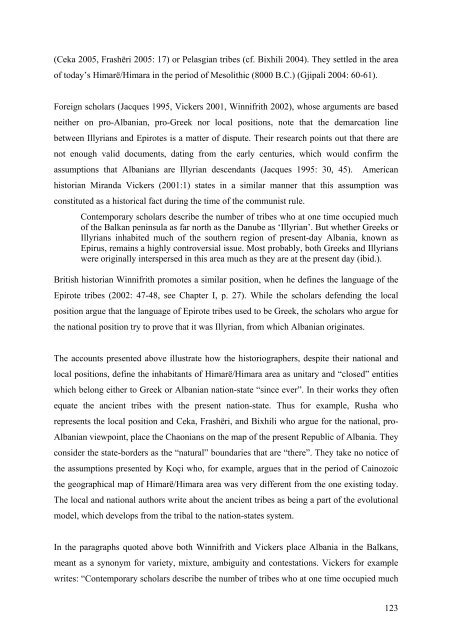university of nova gorica graduate school contested spaces and ...
university of nova gorica graduate school contested spaces and ...
university of nova gorica graduate school contested spaces and ...
You also want an ePaper? Increase the reach of your titles
YUMPU automatically turns print PDFs into web optimized ePapers that Google loves.
(Ceka 2005, Frashëri 2005: 17) or Pelasgian tribes (cf. Bixhili 2004). They settled in the area<br />
<strong>of</strong> today’s Himarë/Himara in the period <strong>of</strong> Mesolithic (8000 B.C.) (Gjipali 2004: 60-61).<br />
Foreign scholars (Jacques 1995, Vickers 2001, Winnifrith 2002), whose arguments are based<br />
neither on pro-Albanian, pro-Greek nor local positions, note that the demarcation line<br />
between Illyrians <strong>and</strong> Epirotes is a matter <strong>of</strong> dispute. Their research points out that there are<br />
not enough valid documents, dating from the early centuries, which would confirm the<br />
assumptions that Albanians are Illyrian descendants (Jacques 1995: 30, 45). American<br />
historian Mir<strong>and</strong>a Vickers (2001:1) states in a similar manner that this assumption was<br />
constituted as a historical fact during the time <strong>of</strong> the communist rule.<br />
Contemporary scholars describe the number <strong>of</strong> tribes who at one time occupied much<br />
<strong>of</strong> the Balkan peninsula as far north as the Danube as ‘Illyrian’. But whether Greeks or<br />
Illyrians inhabited much <strong>of</strong> the southern region <strong>of</strong> present-day Albania, known as<br />
Epirus, remains a highly controversial issue. Most probably, both Greeks <strong>and</strong> Illyrians<br />
were originally interspersed in this area much as they are at the present day (ibid.).<br />
British historian Winnifrith promotes a similar position, when he defines the language <strong>of</strong> the<br />
Epirote tribes (2002: 47-48, see Chapter I, p. 27). While the scholars defending the local<br />
position argue that the language <strong>of</strong> Epirote tribes used to be Greek, the scholars who argue for<br />
the national position try to prove that it was Illyrian, from which Albanian originates.<br />
The accounts presented above illustrate how the historiographers, despite their national <strong>and</strong><br />
local positions, define the inhabitants <strong>of</strong> Himarë/Himara area as unitary <strong>and</strong> “closed” entities<br />
which belong either to Greek or Albanian nation-state “since ever”. In their works they <strong>of</strong>ten<br />
equate the ancient tribes with the present nation-state. Thus for example, Rusha who<br />
represents the local position <strong>and</strong> Ceka, Frashëri, <strong>and</strong> Bixhili who argue for the national, pro-<br />
Albanian viewpoint, place the Chaonians on the map <strong>of</strong> the present Republic <strong>of</strong> Albania. They<br />
consider the state-borders as the “natural” boundaries that are “there”. They take no notice <strong>of</strong><br />
the assumptions presented by Koçi who, for example, argues that in the period <strong>of</strong> Cainozoic<br />
the geographical map <strong>of</strong> Himarë/Himara area was very different from the one existing today.<br />
The local <strong>and</strong> national authors write about the ancient tribes as being a part <strong>of</strong> the evolutional<br />
model, which develops from the tribal to the nation-states system.<br />
In the paragraphs quoted above both Winnifrith <strong>and</strong> Vickers place Albania in the Balkans,<br />
meant as a synonym for variety, mixture, ambiguity <strong>and</strong> contestations. Vickers for example<br />
writes: “Contemporary scholars describe the number <strong>of</strong> tribes who at one time occupied much<br />
123

















